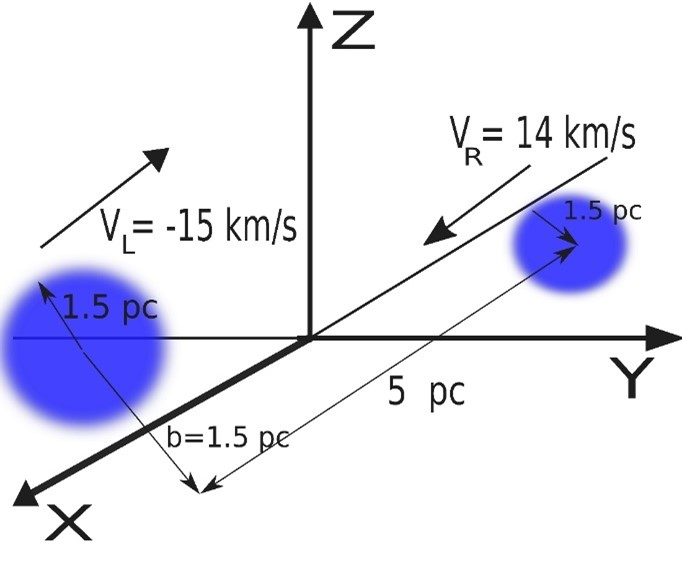Modelo computacional de la formación de cúmulos proto-estelares
aplicación a “the Brick”
DOI:
https://doi.org/10.36790/epistemus.v16i33.225Palabras clave:
astrofisica, computacion, simulaciones, protoestrellasResumen
En el presente trabajo se exponen los resultados de un proyecto de simulación numérica diseñado para estudiar el proceso de formación de la nube interestelar conocida como "the Brick". Dicha nube está localizada cerca del centro de la Vía Láctea. El proceso de formación simulado está basado en la colisión de dos sub-nubes de gas que están contenidas en una nube progenitora mayor. Una característica fundamental es que el gas que simulamos muestra velocidades turbulentas. Estudiamos los resultados de varias simulaciones que representan bien algunos casos de interés académico, además del caso de la nube “the Brick”. Adicionalmente, calculamos las propiedades físicas de los grupos de proto-estrellas resultantes de tales modelos. Por la masa obtenida, dichos grupos se pueden identificar como cúmulos proto-estelares.
Descargas
Citas
P. H. Bodenheimer, Principles of star formation, Springer-Verlag, 2011. DOI: https://doi.org/10.1007/978-3-642-15063-0
A. Rimmer, “The very hungry Universe”, Astronomy, June 2022. https://astronomy.com/issues/2022/june-2022.
V. Springel, “The cosmological simulation code GADGET-2”, Monthly Notices of the Royal Astronomical Society,Vol. 364, pp.1105, 2005. DOI: https://doi.org/10.1111/j.1365-2966.2005.09655.x
G. Arreaga-Garcia, “The effects on a core collapse of the changes in the number and size of turbulent modes of velocity”, Revista Mexicana de Astronomia y Astrofisica, Vol. 53, Num.2, pp.361-384. 2017.
R.I. Yamada, Y. Fukui, H. Sano, K. Tachihara, J.H. Bieging, R. Enokiya, A. Nishimura, S. Fujita, M. Kohno y K. Tsuge, arXiv:2106.01852, 2021.
E. Roslowsky, G. Engargiola, R. Plambeck and L. Blitz, “Giant molecular clouds in M33. High resolution observations”, The Astrophysical Journal, vol. 599, pp.258-274, 2003. DOI: https://doi.org/10.1086/379166
A. Bolatto, A.Leroy, E. Roslowsky, F. Walter and L. Blitz, “The resolved properties of extragalactic giant molecular clouds”, The Astrophysical Journal, vol. 686, pp.948-965, 2008. DOI: https://doi.org/10.1086/591513
Longmore, S.N., Rathborne, J., Bastian, N., Alves, J., Ascenso, J., Bally, J., Testi, L., Longmore, A., Battersby, C., Bressert, E., Purcell, C., Walsh, A., Jackson, J., Foster, J., Molinari, S., Meingast, S., Amorim, A., Lima, J., Marques, R., Moitinho, A., Pinhao, J., J. Rebordao, J. and Santos, F.D., “G0.253+0.016: a molecular cloud progenitor of an Arches-like cluster” , The Astrophysical Journal, vol. 746, pp.117-127, 2012. DOI: https://doi.org/10.1088/0004-637X/746/2/117
C.J. Clarke y R.F.Carswell, Principles of astrophysical fluids dynamics, Cambridge, 2009.
C. Federrath, “The turbulent formation of stars”, Physics Today, vol. 71, Num. 6, pp.38-42, 2018. DOI: https://doi.org/10.1063/PT.3.3947
M. R. Krumholz, “New theory of star formation”, Astronomy, February 2008,
https://astronomy.com/news/2008/02/new-theory-of-star-formation
D.Utomo, L.Blitz y E. Falgarone,”The origin of interstellar turbulence in M33“, The Astrophysical Journal, 87117, 2019. DOI: https://doi.org/10.3847/1538-4357/aaf582

Publicado
Cómo citar
Número
Sección
Licencia
Derechos de autor 2022 EPISTEMUS

Esta obra está bajo una licencia internacional Creative Commons Atribución-NoComercial-CompartirIgual 4.0.
La revista adquiere los derechos patrimoniales de los artículos sólo para difusión sin ningún fin de lucro, sin menoscabo de los propios derechos de autoría.
Los autores son los legítimos titulares de los derechos de propiedad intelectual de sus respectivos artículos, y en tal calidad, al enviar sus textos expresan su deseo de colaborar con la Revista Epistemus, editada semestralmente por la Universidad de Sonora.
Por lo anterior, de manera libre, voluntaria y a título gratuito, una vez aceptado el artículo para su publicación, ceden sus derechos a la Universidad de Sonora para que la Universidad de Sonora edite, publique, distribuya y ponga a disposición a través de intranets, internet o CD dicha obra, sin limitación alguna de forma o tiempo, siempre y cuando sea sin fines de lucro y con la obligación expresa de respetar y mencionar el crédito que corresponde a los autores en cualquier utilización que se haga del mismo.
Queda entendido que esta autorización no es una cesión o transmisión de alguno de sus derechos patrimoniales en favor de la mencionada institución. La UniSon le garantiza el derecho de reproducir la contribución por cualquier medio en el cual usted sea el autor, sujeto a que se otorgue el crédito correspondiente a la publicación original de la contribución en Epistemus.
Salvo indicación contraria, todos los contenidos de la edición electrónica se distribuyen bajo una licencia de uso y Attribution-NonCommercial-ShareAlike 4.0 International (CC BY-NC-SA 4.0) Puede consultar desde aquí la versión informativa y el texto legal de la licencia. Esta circunstancia ha de hacerse constar expresamente de esta forma cuando sea necesario.















